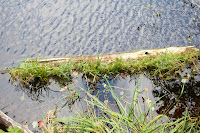Bible: SA did a spontaneous narration of what we've been learning in Leading Little Ones to God.
If we sin and come back to God and say, "God, I did bad things and I did wrong things," and you say, "God, please forgive me," He will forgive us.
Poetry Tea Time: This was only going to be a weekly thing, but it's turned out to be a daily treat. We've been reading a lot from Robert Louis Stevenson's A Child's Garden of Verses, and also a collection called Read Aloud Rhymes for the Very Young. I'd say this is one of our favourite parts of the day, and the boys won't let me miss it.
Math: We love math at our house! I'm planning to post about how we use Miquon Math and Family Math sometime next month. For now, though, I'll share two of the games we've played in the last week.
Dollar Digits: Materials: pennies, dimes, a pair of dice, pencil and paper. Make 10's and a 1's columns on the paper. Take turns throwing the dice. Take the same number of pennies, and write the number down in the 1's column. Every time you have 10 pennies, trade them in for a dime and write the new number in the columns on your paper. The first person to reach 50 cents wins.
Make My Number: Using Cuisenaire rods and a hundreds chart, SA and I took turns choosing any number up to 100 for the other to make using the rods. I had him choose the numbers first while I chose the rods so he'd know how the game went. Of course he began with a big one, 97. Over the course of the game I chose small numbers and big numbers, and he never had any problem. He'd count by 10's using the orange rods till he got to the right number, then chose the appropriate length for the 1's. This was not a challenging activity for him, but I chose to do it because I wanted to make sure that he not only knew the numbers up to 100, but understood the value of the numbers. He did.
Reading: I decided to try some Charlotte Mason style reading instruction. We used the book Chicka Chicka A B C. It's a fun rhyme with good rhythm. We did some exercises to help him recognize the words at sight. Then we did word building (phonics) on the alternate days using words from the poem. (For example, it had the words "meet" and "tree", so we learned the sound ee makes and made some more words by joining different consonants to the suffix -eet.) This was very enjoyable for him, and I will continue in this style of instruction. More on that in another post.
Writing: I am not doing any printing lessons or copywork yet. Up until two weeks ago, SA did not enjoy colouring or using a pencil. I didn't push it. This summer he was showing some signs of readiness (writing his own name, trying to copy words we'd write on a paper for him). Three weeks ago, I bought new pencil crayons, crayons, and markers. Of course, JJ was all over them, and SA caught some of the excitement. I started having a free "pencil crayons and paper" time every morning, where they could do whatever they wanted. Within days, SA was asking me how to spell words and printing them very large on the paper (I love my oversized paper pad!). Within two weeks, he was holding the pencils correctly, and the size of his letters and numbers went down by half. He has even started making and colouring pictures now. All this has just confirmed to me again that I don't need to push things that aren't coming naturally. When he's ready, he will learn quickly.
Nature Study: Our nature walk was at Mooney's Pond. It was an easy trail, and only about 20 minutes from our house. I think it will become a favourite destination for our nature walks. Here are some pictures.


























